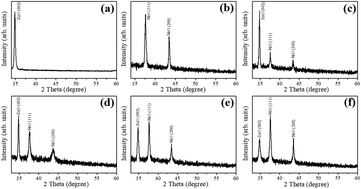The effect of Ni content on gas-sensing behaviors of ZnO–NiO p–n composite thin films grown through radio-frequency cosputtering of ceramic ZnO and NiO targets
Abstract
In this study, dual phase ZnO–NiO p–n composite thin films were grown through radio-frequency cosputtering of ceramic ZnO and NiO targets. During the cosputtering thin-film growth, the sputtering power of NiO was varied from 50 W to 110 W, while the ZnO sputtering power was fixed at 120 W herein. The composition analysis revealed that the Ni content in the composite films varied with the NiO sputtering power and is from 3.6 to 23.7 at%. The structural analysis revealed that the NiO sputtering power substantially changed the relative phase content in the composite film; moreover, the surface morphology and grain size of the composite film are highly dependent on the NiO sputtering power. The surface grain size increased and its morphology changed to a large pyramidal stereo-geometry when the NiO sputtering power was increased above 90 W. The composite crystalline films show different gas-sensing conduction types which are highly dependent on the Ni composition in the composite films. A Ni content of 10.5 at% is an optimal composition for the composite film to obtain superior ethanol gas-sensing performance in comparison with other composite films and pristine ZnO and NiO films. This is attributable to the formation of a suitable number of p–n junctions in the composite film which enhanced its ethanol gas-sensing performance. The experimental results herein demonstrate that manipulation of the ZnO and NiO relative phase content in the composite films through a cosputtering crystal growth process is a promising method to design oxide composite thin-film gas sensors with satisfactory performance.



 Please wait while we load your content...
Please wait while we load your content...